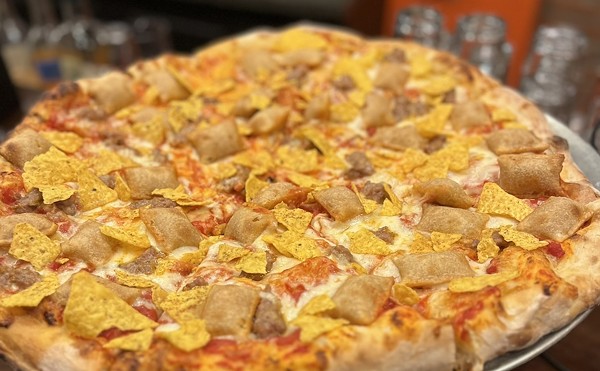No, we said. We loved it.
She wasn't convinced. Were we sure? And again, when we didn't finish everything we'd ordered, she eyed our kitfo warily. Were we really full?
I guess few diners at Meskerem Ethiopian Restaurant order kitfo raw. A shame.
Meskerem's menu compares kitfo to steak tartare. The dishes certainly look more or less identical: A mound of chopped raw beef resembles nothing but a mound of chopped raw beef. But the flavor of kitfo is something else entirely, a pure iron tang that smacks you in the mouth and then peppers the wound. The meat is so luscious that it almost dissolves within its pocket of thin, sour injera bread.
Still, we couldn't eat it all. We'd ordered too much: the kitfo and kwanta firfir and a sauté of cabbage, carrots and potatoes, and small side dishes of miser alech and miser wat.
The kwanta firfir was intriguing: dried beef first seasoned with red wine and peppery, but not searing, berbere sauce and then mixed with small pieces of injera. The dried beef wasn't too chewy, but between the injera in the dish and the injera with which I scooped it up, I had trouble picking out its distinct essence.
The sauté of cabbage, carrots and potatoes ("vegetable combo #2"), on the other hand, was excellent, with a mild flavor of garlic and ginger that was a nice contrast to the strong kitfo. Miser alech and miser wat are, respectively, a mild and a spicy lentil dish — the former yellow with curry, the latter dusky-red with berbere sauce. Both are tasty.
Meskerem opened in March and is a welcome addition to South Grand's business district, the hub of ethnic dining in St. Louis. The address was last occupied by the oddly named (and short-lived) Jasoom Mexican Revolutionary Restaurant & Cantina and, before that, by just plain Jasoom. The new owners kept Jasoom's cheery yellow paint scheme, although the place seems more airy than I remember. I think they removed some booths. At any rate, the new owners also expanded into the space next door to create a second dining room. This is painted a cool, soothing blue.
Ethiopian cuisine is meant to be a communal experience. You order a few dishes (three might be too many for two people but are just right for four). These are served together, each in its own pile, on one large, round piece of injera. You tear off a piece of injera with your hands and use it to scoop up a little of this or that dish.
Just-OK injera is a utensil. Good injera is a light, but essential, layer of flavor, like the spritz of lemon juice on a piece of grilled fish. The injera at Meskerem is very good. I noticed it when eating the "Special Tibs," cubes of pleasantly chewy leg of lamb sautéed with green peppers, onions and tomatoes in Ethiopian honey wine and awaze sauce (a milder berbere sauce). The sour injera drew the lamb's natural taste out above all the other ingredients, making it a definitive lamb dish rather than simply a stew of flavors.
If you've never tried Ethiopian food, Meskerem would be an ideal introduction. Start with an order of sambosa, meat or lentil pies that look like empanadas and give you a brief introduction to some of the cuisine's basic flavors. They come with a delicious, spicy dipping sauce that will ease you into the more adventurous dishes.
The "Meskerem Combo" lets you sample a straightforward dish of beef in berbere sauce (tibs wat) and a slightly more interesting dish of beef seasoned with garlic, onion and ginger and served with collard greens cooked to just-right bitterness (gomen besaega), as well as helpings of miser alech and miser wat.
Ethiopia is justly famous as the birthplace of coffee, but to blow your mind order the Ethiopian tea, heady with cinnamon, cardamom and cloves — without a doubt the strongest tea I've ever tasted.
Doogh, a drink made from yogurt and dried mint, is popular in Iran and its neighboring countries. At Grand Mediterranean Kabob Café, you can order doogh by the glass or pitcher. This was my first doogh, so I opted for a glass.
The drink was served over ice, which I was happy to see on that unusually warm April afternoon. It looked like two-percent milk, and although it didn't taste like saltwater, exactly, that was my first thought. It's an acquired taste — one that, frankly, I have yet to acquire — but I was glad to try it.
Grand Mediterranean Kabob Café is located roughly a mile south of Meskerem on South Grand, just past Banh Mi So #1 — Saigon Gourmet. (If you pass Al Smith's Feasting Fox, you've gone a block too far.) It's an unassuming space. You enter into a room with a sit-down bar, a jukebox that plays Persian tunes and a few tables. In the next room is seating for about 30, the tables covered with clear vinyl tablecloths that resemble shower-curtain liners.
The menu covers two sides of a legal-size sheet of paper. One side features your typical American bar-and-grill selections: burgers, chicken tenders, onion rings, French fries and even deep-fried ravioli. There's a gyro plate and a pita wrap with either a beef or chicken kabob. On my first visit, I ordered the beef-kabob pita wrap to go. The kabob itself was good, a strip of ground beef with that signature blend of char and onion and tangy spices. But it was slathered in what tasted like mayonnaise, as was a chicken pita wrap I sampled on a later visit.
The other side of the menu features Persian dishes: a few kabob plates, a few salads, two appetizers and three entrées. On my second visit, after trying doogh, I ordered the combo kabob plate, which includes one beef kabob and one chicken kabob (actually, four small pieces of chicken) around a pile of fragrant basmati rice. My friend tried an entrée, zereskh polo, basmati rice strewn with barberries and served with what appeared to be the exact same chicken kabob I had. The flavors were direct and satisfying: the tart berries, the smoky chicken.
On this and a third visit I started with kashke-bademjune, a delicious mixture of mashed eggplant seasoned with garlic, onion and mint and topped with a swirl of whey or whey mixed with yogurt. I wanted to try the other appetizer, "Salad Oliviá," apparently a sort of chicken salad, but this wasn't available, so instead I shared the "Persian Salad" of diced cucumbers, onions and tomatoes.
Also unavailable on two visits was ghormeh sabzi, another of the three entrées, a stew of beef, greens and red beans. The third entrée is ghaymeh, described on the menu as "beef with tomato sauce and split peas." In fact, it's a stew, served in a bowl with a handful of French fries bobbing on the surface. The fries were pretty good, but the ghaymeh had the unpleasant flavor of canned beef stock, without a hint of tomato sauce.
Still, for straightforward Persian cuisine, Grand Mediterranean Kabob Café is worth seeking out. Try the doogh. Sometimes, your experience is as revelatory as eating kitfo for the first time. Sometimes, you pass your glass of doogh to a friend, who gladly drinks what you can't.
Have a suggestion for a restaurant the Riverfront Times should review? E-mail [email protected].





